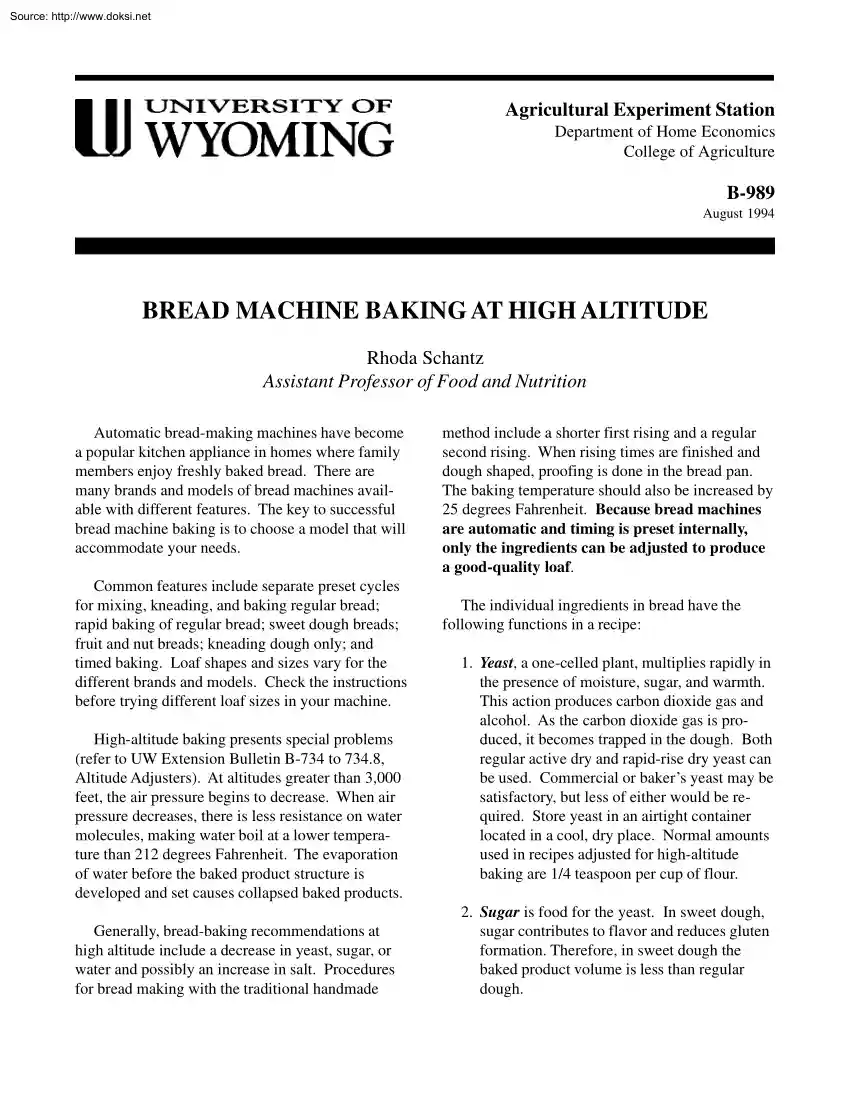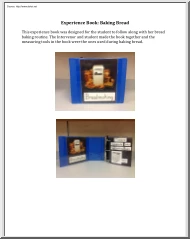Please log in to read this in our online viewer!

Please log in to read this in our online viewer!
No comments yet. You can be the first!
Content extract
Source: http://www.doksinet Agricultural Experiment Station Department of Home Economics College of Agriculture B-989 August 1994 BREAD MACHINE BAKING AT HIGH ALTITUDE Rhoda Schantz Assistant Professor of Food and Nutrition Automatic bread-making machines have become a popular kitchen appliance in homes where family members enjoy freshly baked bread. There are many brands and models of bread machines available with different features. The key to successful bread machine baking is to choose a model that will accommodate your needs. Common features include separate preset cycles for mixing, kneading, and baking regular bread; rapid baking of regular bread; sweet dough breads; fruit and nut breads; kneading dough only; and timed baking. Loaf shapes and sizes vary for the different brands and models. Check the instructions before trying different loaf sizes in your machine. High-altitude baking presents special problems (refer to UW Extension Bulletin B-734 to 734.8, Altitude
Adjusters). At altitudes greater than 3,000 feet, the air pressure begins to decrease. When air pressure decreases, there is less resistance on water molecules, making water boil at a lower temperature than 212 degrees Fahrenheit. The evaporation of water before the baked product structure is developed and set causes collapsed baked products. Generally, bread-baking recommendations at high altitude include a decrease in yeast, sugar, or water and possibly an increase in salt. Procedures for bread making with the traditional handmade method include a shorter first rising and a regular second rising. When rising times are finished and dough shaped, proofing is done in the bread pan. The baking temperature should also be increased by 25 degrees Fahrenheit. Because bread machines are automatic and timing is preset internally, only the ingredients can be adjusted to produce a good-quality loaf. The individual ingredients in bread have the following functions in a recipe: 1. Yeast, a
one-celled plant, multiplies rapidly in the presence of moisture, sugar, and warmth. This action produces carbon dioxide gas and alcohol. As the carbon dioxide gas is produced, it becomes trapped in the dough Both regular active dry and rapid-rise dry yeast can be used. Commercial or baker’s yeast may be satisfactory, but less of either would be required. Store yeast in an airtight container located in a cool, dry place. Normal amounts used in recipes adjusted for high-altitude baking are 1/4 teaspoon per cup of flour. 2. Sugar is food for the yeast In sweet dough, sugar contributes to flavor and reduces gluten formation. Therefore, in sweet dough the baked product volume is less than regular dough. Source: http://www.doksinet 3. Salt controls the growth of the yeast Normal amounts are 1/4 to 1 teaspoon per cup of flour. 4. Flour creates bread structure by providing proteins to form an elastic-type substance called gluten. Gluten can form cell walls that hold the carbon dioxide
gas given off by the yeast. The more gluten proteins in flour, the greater possible volume of the loaf. Bread flour has a higher protein content than allpurpose flour and contributes more gluten to the bread. High-gluten flour is simply hard wheat flour with some extra gluten or protein added. Gluten can be added to all-purpose flour and low-gluten grains, such as rye and whole wheat, to increase the volume of the finished loaf. The moisture content of flour may change with relative humidity and storage conditions. Flour moisture can affect the dough and baked loaf. Dry flour acts like a sponge, absorbing more than normal amounts of liquid. Dough made with dry flour is stiff and forms tight, compact loaves. If flour is not dry, the dough becomes soft and sticky, the loaf volume will rise, then fall, and/or the grain is large or coarse. Store flour in an airtight container in a cool, dry place to maintain appropriate moisture level, freshness, and baking quality. Never store flour near
heat because this will dry out the flour! 5. Liquid such as water and/or milk is necessary to activate the dry yeast. Water makes bread crusty and allows a wheat-like flavor to develop in the bread; milk makes a velvety texture and a creamy color. Milk also improves the nutritional value of bread by adding calcium. If dry milk solids are used, they should be added to the dry ingredients using 1/3 cup of dry milk solids for each cup of water. 6. Fat or oil lubricate strands of gluten, enabling them to stretch easily and produce a high loaf with good grain and texture. Normal amounts are zero to 1 tablespoon per cup of flour. RECOMMENDATIONS 1. Follow the instructions that come with the bread machine. a. Place ingredients into the baking pan in the order recommended by the manufacturer of your machine. b. Have all ingredients at the proper temperature, especially the liquid, recommended by the manufacturer of your machine. 2. Measure all ingredients accurately a. Use standard household
measuring cups and spoons. b. Use standardized measuring techniques For dry ingredients, stir while in canister (no sifting needed), spoon into measuring cup, and level off with a straight edge. With liquid ingredients, place measuring cup on level surface and pour in liquid and read at eye level. 3. Most recipes do not need to be adjusted, but problems do occur sometimes. Here are some symptoms along with their trouble-shooting techniques. Remember to make only one adjustment at a time and keep a record of the successful changes. a. Fallen loaf (over-rises, then falls; has a mushroom appearance) - too much yeast, reduce by 1/4 teaspoon per three cups flour; too much sugar, reduce by 1/2 the amount per three cups flour; too little salt, increase by 1/8 teaspoon per three cups flour. b. Sunken loaf (sinks from the beginning of baking; has a caved-in appearance) - too much water, decrease by 1/8 cup per three cups flour. c. Uneven top (gnarled top; looks very rugged) - not enough water,
increase by 1/8 cup per three cups flour. Most bread machines have trouble-shooting sections in the instruction manuals. Follow manufacturer instructions to correct any problems. Source: http://www.doksinet 4. The temperature of the room should be moderate (60 to 70 degrees Fahrenheit). Keep the machine free from drafts. Opening and closing the door of the machine also causes drafts, and can affect the bread dough during rising cycles. 5. You can have the bread machine mix, knead, and ferment the dough, then bake it in regular bread pans or as rolls in a conventional oven. RECIPE 4. A large loaf tends to over-proof in the regular baking cycle because the preset rising times are too long for high-altitude bread baking. If choosing the large loaf size, allow the bread machine to mix the ingredients, then remove dough from bread machine pan and allow to rise according to handmade bread instructions. 5. Remove bread from the oven and pan as soon as it is finished baking. Otherwise it
will become soggy or get caved-in sides. 6. Allow bread to cool on a wire rack before cutting or storing. The following standardized whole wheat bread recipe was formulated to work reasonably well in all machines evaluated for this study at an altitude of at least 7,200 feet. Remember to place ingredients into the bread pan in the order recommended by the manufacturer of your bread machine. RESOURCES AVAILABLE 1. Handbook of Food Preparation 1993 Kendall/Hunt Publishing Col. Dubuque, Iowa. ISBN 0-8403-8670-2 WHOLE WHEAT BREAD Yield: 1 medium-sized loaf (1 pound) 1 1/8 cups water 1 tablespoon oil 1 cup flour, all-purpose or bread 2 cups whole wheat flour 2 tablespoons sugar, or molasses, or honey 1 1/2 tablespoons dry milk 1 1/4 teaspoon salt 1 teaspoon dry yeast, regular dry active or rapid rise Helpful Tips 1. To make the kneading blade easier to remove from the loaf after baking, rub the kneading blade with oil or shortening. 2. To make the loaf a lighter consistency, add 1 to 2
tablespoons wheat gluten. 3. To keep added nuts, fruits, or cheese from sinking to the bottom of the loaf, toss in flour before adding to the dough. 2. Altitude Adjusters University of Wyoming Extension Bulletin B-734, b-734.8 3. Electric Bread 1991 Innovative Cooking Enterprises, Inc. Anchorage, Alaska ISBN 0-9629831-1-X. 4. The Bread Machine Cookbook 1991 ISBN 1-55867-025-4. The Bread Machine Cookbook # II. 1991 ISBN 1-55867-037-8 The Bread Machine Cookbook # III. 1992 ISBN 1-55867-048-3. The Bread Machine Cookbook # IV. Whole Grains and Natural Sugars 1992 ISBN 1-55867-049-1. Bristol Publishing Enterprises, Inc. San Leandro, California, by Donna Rathmalt German. 5. The Breadman’s Healthy Bread Book 1992 William Morrow and Co., Inc New York By George Burnett and Trillium Health Products. ISBN 0-688-12025-3. 6. Bread Machine Bounty 1992 Better Homes and Gardens® Books. Des Moines, Iowa ISBN 0-696-01992-2. Source: http://www.doksinet BREAD MACHINES EVALUATED FOR THIS BULLETIN 1.
DAK model FAB-100-1 2. Panasonic model SD-BT55P 3. Seiko model HB-10W 4. Regal model K6771 5. Welbilt model ABM600-1 6. Zojirushi model BBCC-S15 ACKNOWLEDGEMENTS Nancy Mather, extension nutrition specialist, for organizing and directing the focus group in the southwest district of Wyoming and for her editorial suggestions. Reviewers: Stella McKinstry, extension educator, Sublette County Mary Kay Wardlaw, extension educator, Albany County Flour donated by: Wheat Montana; Three Forks, MT Machines borrowed from: Joy Hall, office assistant, Department of Home Economics, 1991-93 Deborah Johnson, extension educator, Natrona County Donna Brown, associate professor, Department of Home Economics Trade or brand names used in this publication are used only for the purpose of educational information. The information given herein is supplied with the understanding that no discrimination is intended, and no endorsement information of products by the Agricultural Research Service, Federal
Extension Service, or State Cooperative Extension Service is implied. Nor does it imply approval of products to the exclusion of others which may also be suitable Persons seeking admission, employment, or access to programs of the University of Wyoming shall be considered without regard to race, color, national origin, sex, age, religion, political belief, disability, veteran status and marital or familial status. Persons with disabilities who require alternative means for communication or program information (braille, large print, audiotape, etc.) should contact their local UW Extension Office To file a complaint, write the UW Employment Practices/Affirmative Action Office, University of Wyoming, P.O Box 3354, Laramie Wyoming 82071-3354 Steven F. Horn, Director Agricultural Experiment Station, University of Wyoming, Box 3354, Laramie, WY 82071 8-94/1M/.75
Adjusters). At altitudes greater than 3,000 feet, the air pressure begins to decrease. When air pressure decreases, there is less resistance on water molecules, making water boil at a lower temperature than 212 degrees Fahrenheit. The evaporation of water before the baked product structure is developed and set causes collapsed baked products. Generally, bread-baking recommendations at high altitude include a decrease in yeast, sugar, or water and possibly an increase in salt. Procedures for bread making with the traditional handmade method include a shorter first rising and a regular second rising. When rising times are finished and dough shaped, proofing is done in the bread pan. The baking temperature should also be increased by 25 degrees Fahrenheit. Because bread machines are automatic and timing is preset internally, only the ingredients can be adjusted to produce a good-quality loaf. The individual ingredients in bread have the following functions in a recipe: 1. Yeast, a
one-celled plant, multiplies rapidly in the presence of moisture, sugar, and warmth. This action produces carbon dioxide gas and alcohol. As the carbon dioxide gas is produced, it becomes trapped in the dough Both regular active dry and rapid-rise dry yeast can be used. Commercial or baker’s yeast may be satisfactory, but less of either would be required. Store yeast in an airtight container located in a cool, dry place. Normal amounts used in recipes adjusted for high-altitude baking are 1/4 teaspoon per cup of flour. 2. Sugar is food for the yeast In sweet dough, sugar contributes to flavor and reduces gluten formation. Therefore, in sweet dough the baked product volume is less than regular dough. Source: http://www.doksinet 3. Salt controls the growth of the yeast Normal amounts are 1/4 to 1 teaspoon per cup of flour. 4. Flour creates bread structure by providing proteins to form an elastic-type substance called gluten. Gluten can form cell walls that hold the carbon dioxide
gas given off by the yeast. The more gluten proteins in flour, the greater possible volume of the loaf. Bread flour has a higher protein content than allpurpose flour and contributes more gluten to the bread. High-gluten flour is simply hard wheat flour with some extra gluten or protein added. Gluten can be added to all-purpose flour and low-gluten grains, such as rye and whole wheat, to increase the volume of the finished loaf. The moisture content of flour may change with relative humidity and storage conditions. Flour moisture can affect the dough and baked loaf. Dry flour acts like a sponge, absorbing more than normal amounts of liquid. Dough made with dry flour is stiff and forms tight, compact loaves. If flour is not dry, the dough becomes soft and sticky, the loaf volume will rise, then fall, and/or the grain is large or coarse. Store flour in an airtight container in a cool, dry place to maintain appropriate moisture level, freshness, and baking quality. Never store flour near
heat because this will dry out the flour! 5. Liquid such as water and/or milk is necessary to activate the dry yeast. Water makes bread crusty and allows a wheat-like flavor to develop in the bread; milk makes a velvety texture and a creamy color. Milk also improves the nutritional value of bread by adding calcium. If dry milk solids are used, they should be added to the dry ingredients using 1/3 cup of dry milk solids for each cup of water. 6. Fat or oil lubricate strands of gluten, enabling them to stretch easily and produce a high loaf with good grain and texture. Normal amounts are zero to 1 tablespoon per cup of flour. RECOMMENDATIONS 1. Follow the instructions that come with the bread machine. a. Place ingredients into the baking pan in the order recommended by the manufacturer of your machine. b. Have all ingredients at the proper temperature, especially the liquid, recommended by the manufacturer of your machine. 2. Measure all ingredients accurately a. Use standard household
measuring cups and spoons. b. Use standardized measuring techniques For dry ingredients, stir while in canister (no sifting needed), spoon into measuring cup, and level off with a straight edge. With liquid ingredients, place measuring cup on level surface and pour in liquid and read at eye level. 3. Most recipes do not need to be adjusted, but problems do occur sometimes. Here are some symptoms along with their trouble-shooting techniques. Remember to make only one adjustment at a time and keep a record of the successful changes. a. Fallen loaf (over-rises, then falls; has a mushroom appearance) - too much yeast, reduce by 1/4 teaspoon per three cups flour; too much sugar, reduce by 1/2 the amount per three cups flour; too little salt, increase by 1/8 teaspoon per three cups flour. b. Sunken loaf (sinks from the beginning of baking; has a caved-in appearance) - too much water, decrease by 1/8 cup per three cups flour. c. Uneven top (gnarled top; looks very rugged) - not enough water,
increase by 1/8 cup per three cups flour. Most bread machines have trouble-shooting sections in the instruction manuals. Follow manufacturer instructions to correct any problems. Source: http://www.doksinet 4. The temperature of the room should be moderate (60 to 70 degrees Fahrenheit). Keep the machine free from drafts. Opening and closing the door of the machine also causes drafts, and can affect the bread dough during rising cycles. 5. You can have the bread machine mix, knead, and ferment the dough, then bake it in regular bread pans or as rolls in a conventional oven. RECIPE 4. A large loaf tends to over-proof in the regular baking cycle because the preset rising times are too long for high-altitude bread baking. If choosing the large loaf size, allow the bread machine to mix the ingredients, then remove dough from bread machine pan and allow to rise according to handmade bread instructions. 5. Remove bread from the oven and pan as soon as it is finished baking. Otherwise it
will become soggy or get caved-in sides. 6. Allow bread to cool on a wire rack before cutting or storing. The following standardized whole wheat bread recipe was formulated to work reasonably well in all machines evaluated for this study at an altitude of at least 7,200 feet. Remember to place ingredients into the bread pan in the order recommended by the manufacturer of your bread machine. RESOURCES AVAILABLE 1. Handbook of Food Preparation 1993 Kendall/Hunt Publishing Col. Dubuque, Iowa. ISBN 0-8403-8670-2 WHOLE WHEAT BREAD Yield: 1 medium-sized loaf (1 pound) 1 1/8 cups water 1 tablespoon oil 1 cup flour, all-purpose or bread 2 cups whole wheat flour 2 tablespoons sugar, or molasses, or honey 1 1/2 tablespoons dry milk 1 1/4 teaspoon salt 1 teaspoon dry yeast, regular dry active or rapid rise Helpful Tips 1. To make the kneading blade easier to remove from the loaf after baking, rub the kneading blade with oil or shortening. 2. To make the loaf a lighter consistency, add 1 to 2
tablespoons wheat gluten. 3. To keep added nuts, fruits, or cheese from sinking to the bottom of the loaf, toss in flour before adding to the dough. 2. Altitude Adjusters University of Wyoming Extension Bulletin B-734, b-734.8 3. Electric Bread 1991 Innovative Cooking Enterprises, Inc. Anchorage, Alaska ISBN 0-9629831-1-X. 4. The Bread Machine Cookbook 1991 ISBN 1-55867-025-4. The Bread Machine Cookbook # II. 1991 ISBN 1-55867-037-8 The Bread Machine Cookbook # III. 1992 ISBN 1-55867-048-3. The Bread Machine Cookbook # IV. Whole Grains and Natural Sugars 1992 ISBN 1-55867-049-1. Bristol Publishing Enterprises, Inc. San Leandro, California, by Donna Rathmalt German. 5. The Breadman’s Healthy Bread Book 1992 William Morrow and Co., Inc New York By George Burnett and Trillium Health Products. ISBN 0-688-12025-3. 6. Bread Machine Bounty 1992 Better Homes and Gardens® Books. Des Moines, Iowa ISBN 0-696-01992-2. Source: http://www.doksinet BREAD MACHINES EVALUATED FOR THIS BULLETIN 1.
DAK model FAB-100-1 2. Panasonic model SD-BT55P 3. Seiko model HB-10W 4. Regal model K6771 5. Welbilt model ABM600-1 6. Zojirushi model BBCC-S15 ACKNOWLEDGEMENTS Nancy Mather, extension nutrition specialist, for organizing and directing the focus group in the southwest district of Wyoming and for her editorial suggestions. Reviewers: Stella McKinstry, extension educator, Sublette County Mary Kay Wardlaw, extension educator, Albany County Flour donated by: Wheat Montana; Three Forks, MT Machines borrowed from: Joy Hall, office assistant, Department of Home Economics, 1991-93 Deborah Johnson, extension educator, Natrona County Donna Brown, associate professor, Department of Home Economics Trade or brand names used in this publication are used only for the purpose of educational information. The information given herein is supplied with the understanding that no discrimination is intended, and no endorsement information of products by the Agricultural Research Service, Federal
Extension Service, or State Cooperative Extension Service is implied. Nor does it imply approval of products to the exclusion of others which may also be suitable Persons seeking admission, employment, or access to programs of the University of Wyoming shall be considered without regard to race, color, national origin, sex, age, religion, political belief, disability, veteran status and marital or familial status. Persons with disabilities who require alternative means for communication or program information (braille, large print, audiotape, etc.) should contact their local UW Extension Office To file a complaint, write the UW Employment Practices/Affirmative Action Office, University of Wyoming, P.O Box 3354, Laramie Wyoming 82071-3354 Steven F. Horn, Director Agricultural Experiment Station, University of Wyoming, Box 3354, Laramie, WY 82071 8-94/1M/.75




